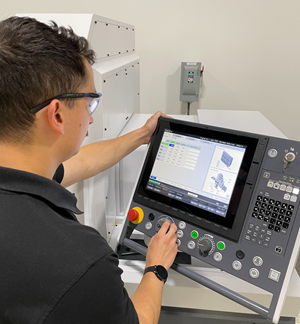Streamlining the Data Network Inside a Machine
As machine tools become more capable of generating data about events and changes that occur within the machine’s internal control system, and the “smart” sensing or measuring devices connected to it, managing this inner network becomes a challenge.
Share



Hwacheon Machinery America, Inc.
Featured Content
View More





As machine tools become more capable of generating data about events and changes that occur within the machine’s internal control system, and the “smart” sensing or measuring devices connected to it, managing this inner network becomes a challenge. As a solution, Marposs has introduced a new concept in process control systems, called BLÚ. According to the product manager, Frank Powell, BLÚ is derived from the company’s roots in electronic systems for machine tool applications. “We now have a system that is based on a distributed network. It consists of a central processing unit located in the machine control panel, and functional nodes for controlling gages, sensors and other devices distributed throughout the machine,” he says.
BLÚ is part of Marposs’ Industry 4.0 “smart factory” initiative, as it facilitates data sharing among various control system devices. Initially, the company is focusing on applications within grinding machines, but the technology promises to make it easier for other machine tool OEMs to “load up” a machine with sensors, gages and other devices that enhance condition monitoring, predictive maintenance and performance reporting.
Mr. Powell says this modular system reduces the cost of installation and maintenance. “A cable for every device is no longer needed, but rather a single cable for the entire system.” The system can be adapted for a variety of uses, from simple control applications through complex integrated production and control systems.
The BLÚ system architecture enables real-time communication between the various internal and external machine functions. The modular system is comprised of a central processing unit located in the machine’s control panel with compact nodes to control functions such as part flagging, gage electromechanical actuation and in-process measurement, acoustic emission sensing, wheel balancing, and process monitoring. The modular architecture enables users to modify the system according to their specific requirements by adding the necessary function nodes and the associated application software packages.
For now, however, the architecture of its network nodes supports technical solutions for machine tools based on current Marposs measuring and process control sensors, which are tailored for grinding machine applications.
The individual system elements that make up the control network may be connected together at various distances from each other, depending on the layout of the specific machine. The system includes nodes that can be positioned inside the cabinet, and others that can be installed close to the working area and are suitable for harsh environmental conditions.
Just as an external shop network relies on operating software for functionality and efficiency, a data network within a machine also relies on software meeting similar requirements. In this case, Mr. Powell says, the BLÚ system software is designed along the lines of interactively programmable operating cycles displayed in a language that has intuitive menus and a customizable human interface. The system has been designed so that the machine programmable logic controller management uses as few I/O signals as possible. It can be installed as a slave in current PLC networks. The system also includes self-diagnostic software.
Because grinding technology is rapidly evolving and becoming more capable, developers at Marposs designed the BLÚ system for a sampling frequency of 45,000 Hz and a measurement resolution of 10 nanometers. This makes it ready for increases in machine-axis resolution and material-removal rates, regardless of the type of surface being processed, in the next generation of grinders. However, this capability also adds value to applications in other types of machine tools.
Details on this control network can be found at blu.marposs.com or by contacting Marposs Corp. at 248-370-0404.
Related Content
Manufacturer, Integrator, Software Developer: Wolfram Manufacturing is a Triple Threat
Wolfram Manufacturing showcased its new facility, which houses its machine shop along with space for its work as a provider of its own machine monitoring software and as an integrator for Caron Engineering.
Read MoreSwiss-Type Control Uses CNC Data to Improve Efficiency
Advanced controls for Swiss-type CNC lathes uses machine data to prevent tool collisions, saving setup time and scrap costs.
Read MoreProtecting Your Automation Investments
Shops need to look at their people, processes and technology to get the most of out their automation systems.
Read MoreLeveraging Data to Drive Manufacturing Innovation
Global manufacturer Fictiv is rapidly expanding its use of data and artificial intelligence to help manufacturers wade through process variables and production strategies. With the release of a new AI platform for material selection, Fictive CEO Dave Evans talks about how the company is leveraging data to unlock creative problem solving for manufacturers.
Read MoreRead Next
Building Out a Foundation for Student Machinists
Autodesk and Haas have teamed up to produce an introductory course for students that covers the basics of CAD, CAM and CNC while providing them with a portfolio part.
Read More5 Rules of Thumb for Buying CNC Machine Tools
Use these tips to carefully plan your machine tool purchases and to avoid regretting your decision later.
Read MoreSetting Up the Building Blocks for a Digital Factory
Woodward Inc. spent over a year developing an API to connect machines to its digital factory. Caron Engineering’s MiConnect has cut most of this process while also granting the shop greater access to machine information.
Read More
































.jpg;maxWidth=300;quality=90)











